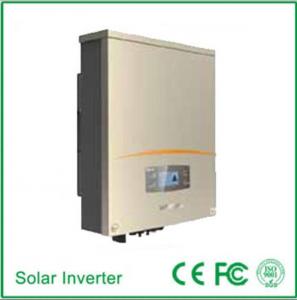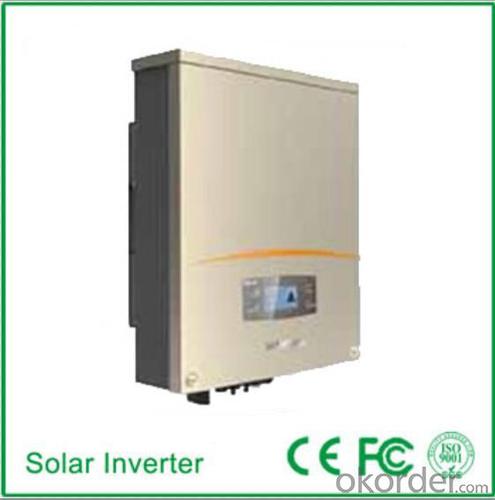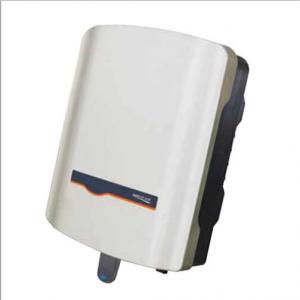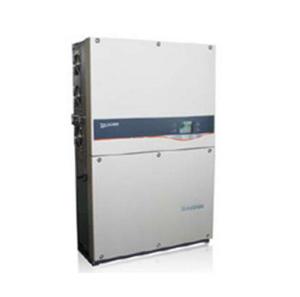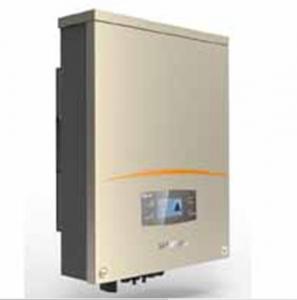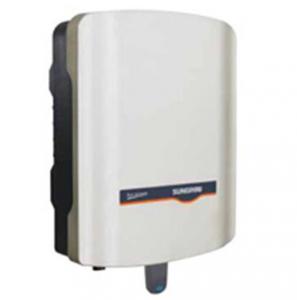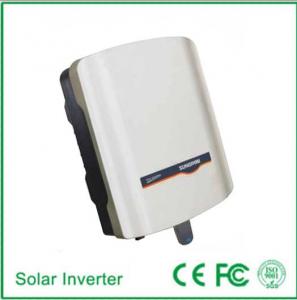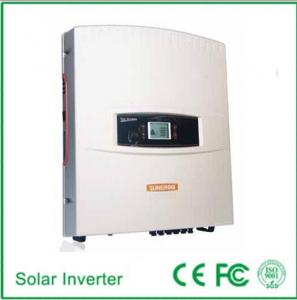Satcon Solar Inverter SG3KTL-EC
- Loading Port:
- China Main Port
- Payment Terms:
- TT or LC
- Min Order Qty:
- 50000 unit
- Supply Capability:
- 300000 unit/month
OKorder Service Pledge
OKorder Financial Service
You Might Also Like
1. Structure of Solar Photovoltaic Grid-Connected Inverter SG3KTL-EC Description
A solar inverter, or PV inverter, or Solar converter, converts the variable direct current (DC) output of a photovoltaic (PV) solar panel into a
utility frequency alternating current (AC) that can be fed into a commercial electrical grid or used by a local, off-grid electrical network. It is a
critical BOS–component in a photovoltaic system, allowing the use of ordinary AC-powered equipment. Solar inverters have special
functions adapted for use with photovoltaic arrays, including maximum power point tracking and anti-islanding protection.
2. Main Features of the Solar Photovoltaic Grid-Connected Inverter SG3KTL-EC
• Flexible design due to dual MPP tracking that is equipped to obtain full nominal power, 3-phase supply
• High energy yield due to maximum efficiency up to 98.1%
• Low noise levels and internal consumption due to natural cooling
• Integrated theft protection
• Access to Home WiFi system and enjoy cloud services via smart phones
• Integrated power management function, easy to receive the adjustable command from grid
• Extensive communication: RS-485, Ethernet, WLAN / WiFi, 4 digital inputs for ripple control receivers
• Product certification: TÜV, VDE 0126-1-1, EN 62109-1/-2, CE, G83/1, VDE-AR-N 4105
• Manufacturer certification: ISO 9001, ISO 14001, OHSAS 18000
3. Solar Photovoltaic Grid-Connected Inverter SG3KTL-EC Images
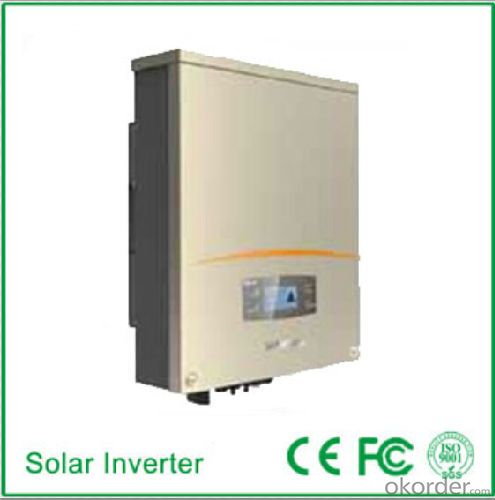
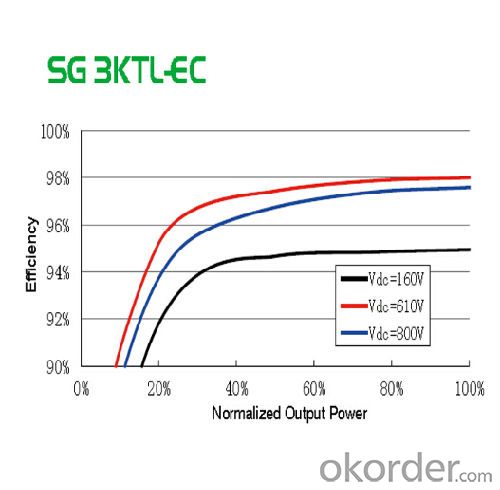

4. Solar Photovoltaic Grid-Connected Inverter SG3KTL-EC Specification
Input Side Data | |
Max. PV input power | 3191W |
Max. PV input voltage | 1000V |
Startup voltage | 200V |
Nominal input voltage | 610V |
MPP voltage range | 140~900V |
MPP voltage range for nominal power | 160~800V |
No. of MPPTs | 2 |
Max. number of PV strings per MPPT | 1/1 |
Max. PV input current | 19.8A(9.9A/9.9A) |
Max. current for input connector | 10A |
Short-circuit current of PV input | 24.8A(12.4A/12.4A) |
Output Side Data | |
Nominal AC output power | 3000W |
Max AC output power(PF=1) | 3000W |
Max. AC output apparent power | 3000VA |
Max. AC output current | 4.4A |
Nominal AC voltage | 3/N/PE,230/400Vac |
AC voltage range | 310~480Vac(May vary as per corresponding country's grid standard) |
Nominal grid frequency | 50Hz |
Grid frequency range | 45~55Hz |
THD | < 3 % (Nominal power) |
DC current injection | <0.5 %In |
Power factor | >0.99@default value at nominal power, |
Protection | |
Anti-islanding protection | Yes |
LVRT | No |
DC reverse connection protection | Yes |
AC short circuit protection | Yes |
Leakage current protection | Yes |
DC switch | Integrated |
DC fuse | No |
Overvoltage protection | III |
System Data | |
Max. efficiency | 98.0% |
Max. European efficiency | 96.0% |
Isolation method | Transformerless |
Ingress protection rating | IP65 |
Night power consumption | <1W |
Operating ambient temperature range | -25~60℃(>45℃ derating) |
Allowable relative humidity range | 0~100% |
Cooling method | Natural cooling |
Noise | ≤29dB |
Max. operating altitude | 2000m |
Display | Graphic LCD |
Communication | Ethernet,RS485(RJ45 connector), |
DC connection type | MC4 |
AC connection type | Plug and play connector |
Certification | VDE0126-1-1,EN62109-1,EN62109-2, |
Mechanical Data | |
Dimensions(W×H×D) | 403×518×190mm |
Mounting method | Wall bracket |
Weight | 22kg |
5. FAQ of Solar Photovoltaic Grid-Connected Inverter SG3KTL-EC
Q1. What is the difference between inverter and solar inverter?
A1. Inverter only has AC inpput, but solar inverter both connect to AC input and solar panel, it saves more power.
Q2. What is the difference between MPPT&PWM?
A2. MPPT has higher efficiency, it can track the max power point and won't waste energy.
- Q: Can a solar inverter be used with a solar-powered irrigation system?
- Yes, a solar inverter can be used with a solar-powered irrigation system. The solar inverter is responsible for converting the direct current (DC) generated by the solar panels into alternating current (AC) that can be used to power the irrigation system. This allows the solar energy to be efficiently utilized for irrigation purposes.
- Q: Can a solar inverter be used for both single-phase and three-phase applications?
- No, a solar inverter cannot be used for both single-phase and three-phase applications. The type of inverter required depends on the specific electrical requirements of the system. Single-phase inverters are designed for single-phase applications, while three-phase inverters are specifically designed for three-phase applications.
- Q: What are the potential risks of short-circuiting a solar inverter?
- Short-circuiting a solar inverter can pose several potential risks. Firstly, it can cause damage to the inverter itself, leading to its malfunction or complete failure. Secondly, it can result in overheating of the inverter, which may increase the risk of fire or electrical hazards. Additionally, short-circuiting can disrupt the flow of electricity, potentially causing damage to other connected equipment or appliances. Lastly, it may void the warranty of the solar inverter, resulting in additional expenses for repairs or replacements. Therefore, it is crucial to take proper precautions and avoid short-circuiting the solar inverter to ensure its safe and efficient operation.
- Q: Can a solar inverter convert DC power to AC power?
- Yes, a solar inverter can convert DC power generated by solar panels into AC power that is suitable for use in homes and businesses.
- Q: Can a solar inverter be used with different monitoring platforms?
- Yes, a solar inverter can be used with different monitoring platforms as long as the monitoring platforms are compatible with the inverter's communication protocols and data formats.
- Q: What is the role of power ramp rate control in a solar inverter?
- The role of power ramp rate control in a solar inverter is to ensure a smooth and controlled increase or decrease in power output from the solar panels. This control mechanism is important to prevent sudden changes in power generation that can lead to instability in the electrical grid. By gradually adjusting the power output, the solar inverter helps to maintain grid stability, avoid voltage and frequency fluctuations, and ensure a reliable and consistent energy supply.
- Q: Can a solar inverter be used with different types of power control devices?
- Yes, a solar inverter can be used with different types of power control devices. Solar inverters are designed to convert the direct current (DC) produced by solar panels into alternating current (AC) that can be used to power various electrical devices. They can be integrated with different power control devices such as charge controllers, smart energy management systems, and battery storage systems to optimize the efficiency and performance of the solar power system.
- Q: How does a solar inverter handle frequency fluctuations in the grid?
- A solar inverter handles frequency fluctuations in the grid by continuously monitoring the frequency of the grid. If the frequency deviates from the standard value, the inverter adjusts its output frequency accordingly to match the grid frequency. This helps maintain stability in the grid and ensures efficient power generation and distribution.
- Q: How does a solar inverter interact with the electrical grid?
- A solar inverter interacts with the electrical grid by converting the direct current (DC) electricity generated by solar panels into alternating current (AC) electricity that is compatible with the grid. It synchronizes the generated electricity with the grid's voltage and frequency, allowing excess power to be fed back into the grid for others to use, and drawing additional power from the grid when needed. This interaction ensures efficient utilization of solar energy and seamless integration of solar power into the existing electrical grid infrastructure.
- Q: What is the role of a solar inverter in a solar-powered remote monitoring system?
- The role of a solar inverter in a solar-powered remote monitoring system is to convert the direct current (DC) electricity generated by the solar panels into alternating current (AC) electricity that can be used to power the monitoring system. It also ensures that the electricity generated matches the requirements of the monitoring equipment, regulates the voltage, and assists in efficient power transmission and distribution.
Send your message to us
Satcon Solar Inverter SG3KTL-EC
- Loading Port:
- China Main Port
- Payment Terms:
- TT or LC
- Min Order Qty:
- 50000 unit
- Supply Capability:
- 300000 unit/month
OKorder Service Pledge
OKorder Financial Service
Similar products
Hot products
Hot Searches
Related keywords
